StephenZozaya
Not so new Member
This past weekend a friend and I drove south to the Mackay area to look for the 4 species of leaf-tailed gecko (Phyllurus) that are endemic to the area. We had two nights to find all four species, none of which are sympatric. Barriers of low-lying dry sclerophyll forest have kept the different geckos separate, facilitating their speciation. This story is repeated in several other reptile and amphibian taxa on Australia's eastern coast, which has experienced several rainforest expansions and retractions throughout prehistory. And so with the prospect of very little sleep ahead of us we set of to find the first and most northerly-occurring of the four geckos: Phyllurus ossa.
Mount Ossa leaf-tailed gecko (Phyllurus ossa)




These geckos inhabit large boulders within rainforest and seem to be especially common closer to creeks. The boulders on which the geckos are found had a surprisingly large number of Eulamprus amplus sleeping on them. We saw several dozens of these skinks over the short trip, but I only made an effort to photograph this small one.
Lemon-barred forest-skink (Eulamprus amplus)

The next gecko on the list was the Mount Jukes leaf-tailed gecko (Phyllurus isis). This species is found only on two adjacent mountains north of the city of Mackay. Despite searching we failed to turn up the gecko, but we did see a few other neat things and about 3.85 trillion cane toads.
Squirrel glider (Petaurus norfolcensis)
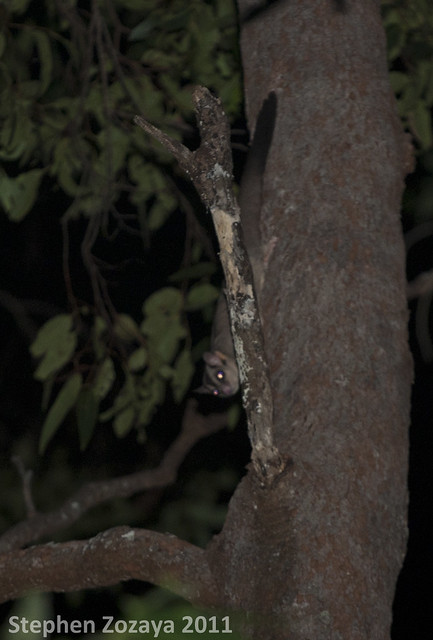
Australian red-eyed treefrog (Litoria chloris). I have no idea where all the black crap came from, and I somehow didn't notice it at the time. I blame sleep deprivation.
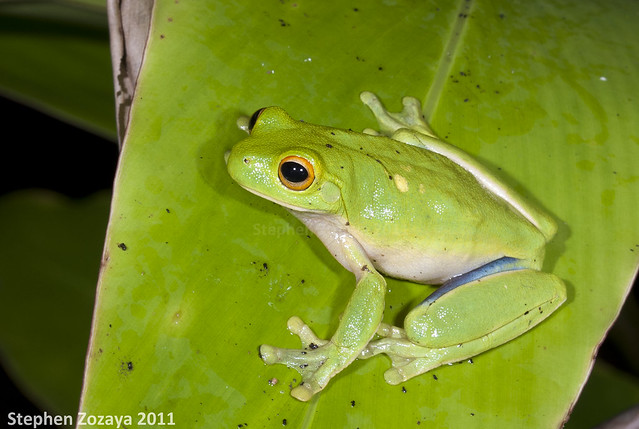
Disappointed but not discouraged, and despite the already ungodly hour, we set off towards Eungella National Park to find the peppered leaf-tailed gecko (Phyllurus nepthys). Our first stop was the Finch Hatton area. No geckos showed themselves, but we weren't without compensation.
Golden-crowned snake (Cacophis squamulosus)
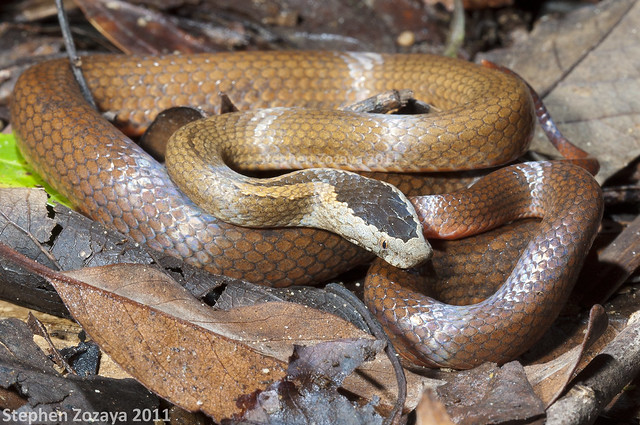

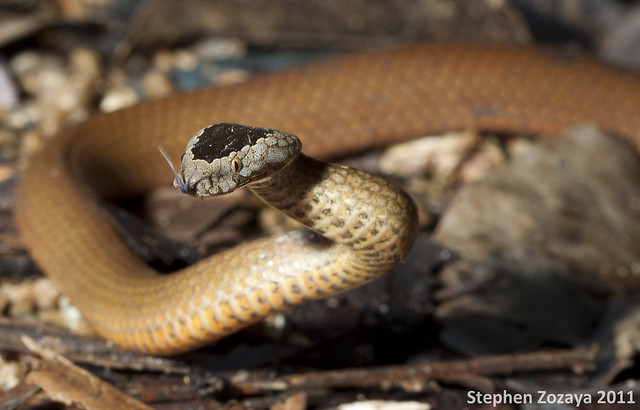
Heading up the Clarke Range into the Eungella Plateau we stopped for a snake on the road. It turned out not to be a snake but rather the three-clawed burrowing skink (Anomalopus verreauxii). I was rather pleased since this was a new species for me and I'm somewhat of a fossorial skink fanatic.
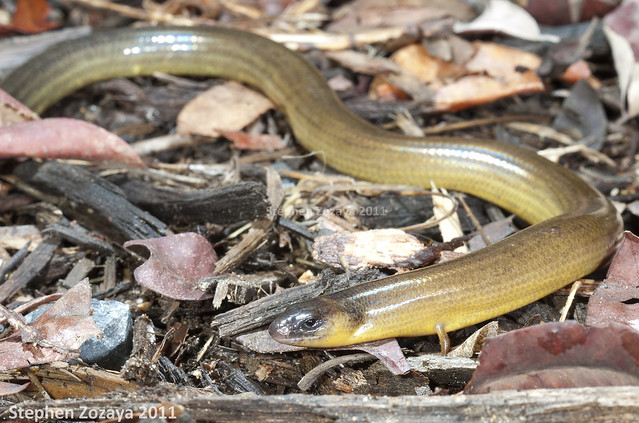
Here you can see its little-bitty claws on the front limb.
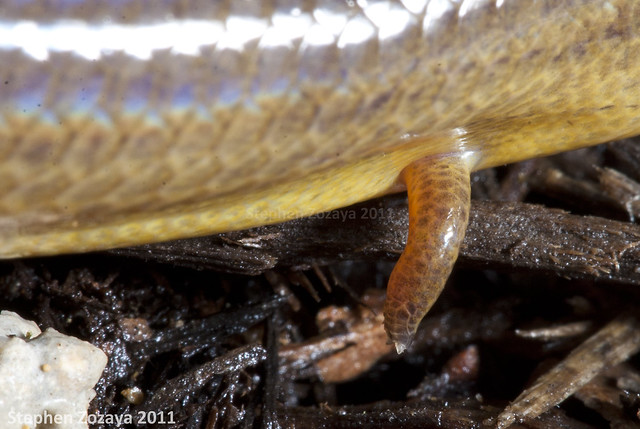
Finally we stopped to continue our search for Phyllurus nepthys. Once again it was proving oddly difficult to find. With fatigue setting in and the sun slowly beginning to creep out we set off to get some sleep. After watching and waving my fist at a feral cat in the forest I looked over to see this fella.
Peppered leaf-tailed gecko (Phyllurus nepthys) with a regenerated tail.


This species is more spinose than its congeners and is the largest of the four leaf-tails in the region. Unlike the majority of the genus, P. nepthys lives primarily on trees rather than boulders. While exploring Eungella NP we managed to find another individual, this time with an original tail, sheltering under some debris. These are probably my favourite Phyllurus so far.

Some upland rainforest, habitat for Phyllurus nepthys.
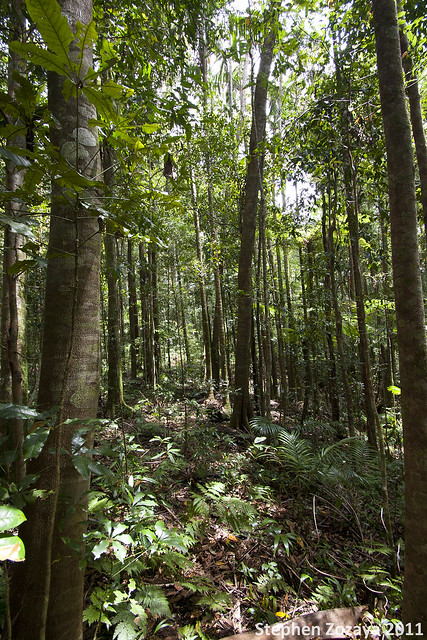
After a quick trip to Mackay to refuel the car and our stomachs it was time to track down the last of the geckos. Phyllurus championae occurs in two separate populations south of Mackay and proved to be the easiest of the geckos to find, despite me inadvertently throwing my hand into some stinging tree. It is the smallest of the 3 species we located (80mm svl) and the second smallest behind P. isis.
Champion's leaf-tailed gecko (Phyllurus championae)
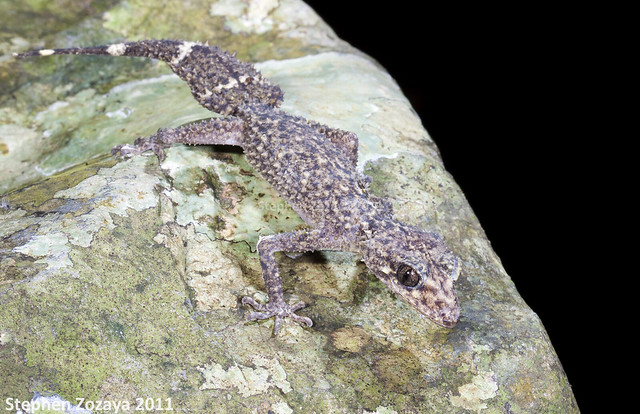


Here is a figure showing the distinctive rostral scales of P. ossa and P. championae.

And so concludes the day-and-a-half leaf-tailed gecko Odyssey. I may have missed P. isis but at least now I have another excuse to return to the area to find the skinky endemics. I hope you found this post enjoyable.
Species seen but not included:
Physignathus lesueurii
Carlia pectoralis
Cryptoblepharus pulcher
Lampropholis adonis
Eulamprus brachysoma
Morelia spilota mcdowelli
Varanus varius
Litoria wilcoxii
Platyplectrum ornatum
Stephen
Mount Ossa leaf-tailed gecko (Phyllurus ossa)




These geckos inhabit large boulders within rainforest and seem to be especially common closer to creeks. The boulders on which the geckos are found had a surprisingly large number of Eulamprus amplus sleeping on them. We saw several dozens of these skinks over the short trip, but I only made an effort to photograph this small one.
Lemon-barred forest-skink (Eulamprus amplus)

The next gecko on the list was the Mount Jukes leaf-tailed gecko (Phyllurus isis). This species is found only on two adjacent mountains north of the city of Mackay. Despite searching we failed to turn up the gecko, but we did see a few other neat things and about 3.85 trillion cane toads.
Squirrel glider (Petaurus norfolcensis)

Australian red-eyed treefrog (Litoria chloris). I have no idea where all the black crap came from, and I somehow didn't notice it at the time. I blame sleep deprivation.

Disappointed but not discouraged, and despite the already ungodly hour, we set off towards Eungella National Park to find the peppered leaf-tailed gecko (Phyllurus nepthys). Our first stop was the Finch Hatton area. No geckos showed themselves, but we weren't without compensation.
Golden-crowned snake (Cacophis squamulosus)



Heading up the Clarke Range into the Eungella Plateau we stopped for a snake on the road. It turned out not to be a snake but rather the three-clawed burrowing skink (Anomalopus verreauxii). I was rather pleased since this was a new species for me and I'm somewhat of a fossorial skink fanatic.

Here you can see its little-bitty claws on the front limb.

Finally we stopped to continue our search for Phyllurus nepthys. Once again it was proving oddly difficult to find. With fatigue setting in and the sun slowly beginning to creep out we set off to get some sleep. After watching and waving my fist at a feral cat in the forest I looked over to see this fella.
Peppered leaf-tailed gecko (Phyllurus nepthys) with a regenerated tail.


This species is more spinose than its congeners and is the largest of the four leaf-tails in the region. Unlike the majority of the genus, P. nepthys lives primarily on trees rather than boulders. While exploring Eungella NP we managed to find another individual, this time with an original tail, sheltering under some debris. These are probably my favourite Phyllurus so far.

Some upland rainforest, habitat for Phyllurus nepthys.

After a quick trip to Mackay to refuel the car and our stomachs it was time to track down the last of the geckos. Phyllurus championae occurs in two separate populations south of Mackay and proved to be the easiest of the geckos to find, despite me inadvertently throwing my hand into some stinging tree. It is the smallest of the 3 species we located (80mm svl) and the second smallest behind P. isis.
Champion's leaf-tailed gecko (Phyllurus championae)



Here is a figure showing the distinctive rostral scales of P. ossa and P. championae.

And so concludes the day-and-a-half leaf-tailed gecko Odyssey. I may have missed P. isis but at least now I have another excuse to return to the area to find the skinky endemics. I hope you found this post enjoyable.
Species seen but not included:
Physignathus lesueurii
Carlia pectoralis
Cryptoblepharus pulcher
Lampropholis adonis
Eulamprus brachysoma
Morelia spilota mcdowelli
Varanus varius
Litoria wilcoxii
Platyplectrum ornatum
Stephen



